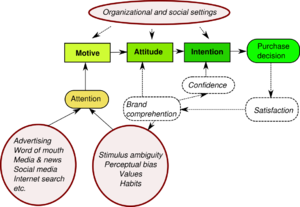Howard Sheth model of consumer behaviour
| Howard Sheth model of consumer behaviour |
|---|
| See also |
Howard-Sheth model is one of models that represent consumer behaviour on the market. It attempts to explain the rationality of choice of the product by the consumer under conditions of incomplete information and reduced processing capability. It analyses the external symptoms of behaviour, reactions and thought processes that cannot be subject to direct observation.
Howard and Sheth model of consumer behaviour variables
Howard-Sheth model (fig. 1) is based on the assumption that the consumer behaves rationally during purchase, process is repeatable and is result of incentives which have their source in the environment (input variables). It consists of four main groups of variables:
I. Input variables, i.e. stimuli arising from the marketing activities and social environment of the consumer. Include three different types of stimuli, which are:
- significant incentives - physical characteristics and the attributes of a product, such as price, quality, originality and accessibility, brand characteristics,
- symbolic incentives - verbal or visual characteristics of the product, form of product perceived by buyer/customer, effect of advertising and promotion messages used by seller,
- social stimuli - whose source is the social consumer environment, family, reference groups, and society in genertal.
II. Hypothetical constructs, including the psychological variables influencing consumer behaviour during the decision-making process. It is regarded by the authors as abstract, not defined and not intended directly. They distinguished two main constructs:
- perceptual constructs - describe obtaining and processing information, attention to stimulus, sensitivity to messages, receptivity, blocking information, prejudice, etc.,
- learning constructs - how buyer forms attitudes, opinions, and knowledge influencing his buying decisions, evaluation after purchase, brand comprehension, etc.
III. Output variables: purchase intention, attitude, brand perception and attention. They are noticeable effects of internal processes, for example: decision to implement the purchase, disclosure of customer view and interest, as well as the declaration of other activities. The most important output variable from the point of view of marketing is actual purchase, because it involves carrying out activity based on consumer preferences. Hierarchy of output variables include:
- attention - scope of information accepted after exposing buyer to stimulus,
- comprehension - amount of information actually processed and stored in buyer mind,
- cognition - forming attitude towards products,
- intention - to buy or not to buy particular product,
- purchase behaviour.
IV. External variables that have not been presented in the Howard and Sheth model and are not direct part of the decision-making process, however, have a significant impact on consumer decisions and are used in marketing activities as a criterion for segmentation. These include such variables as: value of purchase for the buyer, the character traits of the consumer, membership of a social group, the financial status of a consumer, the pressure of time.
See also:
References
- Evans, M., Jamal, A., & Foxall, G. R. (2006). Consumer behaviour. Chichester: John Wiley & Sons.
- Farley, J.U. & Ring, W. (1970), An Empirical Test of the Howard-Sheth Model. Journal of Marketing Research (JMR). Nov, Vol. 7 Issue 4, p427-438. 12p.
- Howard J. A., Sheth J.N. (1969), The Theory of Buyer Behaviour, J. Wiley and Sons, New York.
- Hunt, S. & Pappas, J. (1972), A Crucial Test for the Howard-Sheth Model of Buyer Behavior., Journal of Marketing Research (JMR). Aug, Vol. 9 Issue 3, p346-348.
- Sheth J.N. (1972), The Future of Buyer Behavior Theory, in SV - Proceedings of the Third Annual Conference of the Association for Consumer Research, eds. M. Venkatesan, Chicago, IL: Association for Consumer Research, p. 562-575.
- Solomon, M., Russell-Bennett, R., & Previte, J. (2012). Consumer behaviour. Pearson Higher Education AU.
- Wright, R. (2006). Consumer behaviour. Cengage Learning EMEA.
- Zeithaml V.A. (1988), Consumer Perceptions of Price, Quality, and Value: A Means-End Model and Synthesis of Evidence, Journal of Marketing, Vol. 52, No. 3, Jul., p. 2-22.
Author: Krzysztof Wozniak
